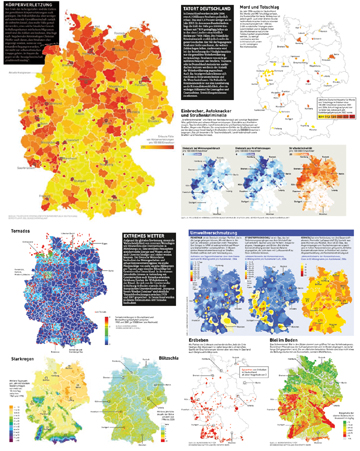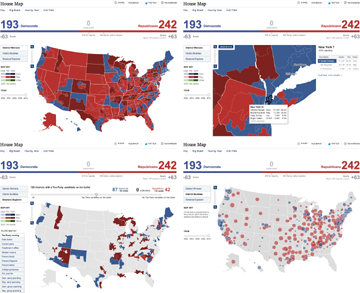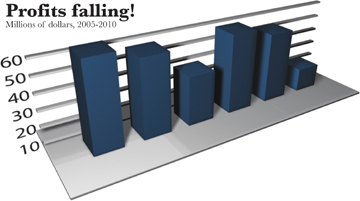Seek Depth
My advice is: No matter what style you choose—whether you decide to follow Tufte and become a hardcore minimalist or adopt a friendlier approach—always take advantage of the space you have available to seek depth within reasonable limits. After that, and only after that, worry about how to make the presentation prettier.
Take a look at the series of maps titled Dangerous Germany in Figure 4.3. They were produced by a company called Golden Section Graphics for SZ Wissen Magazine. Sure, those maps present information, encoding tons of data by means of colors and shapes, but they also allow readers to compare what goes on in the places they live with other areas. In this case, the designer doesn’t force the data to adopt a particular shape just to make a point. The designer works as a facilitator, someone who designs a visual device that readers can use to navigate the figures, freely interpret them, and make their own points.

Figure 4.3. Dangerous Germany, by Golden Section Graphics.
This is more clearly seen in interactive graphics, where the exploration component of visualization becomes crucial. The New York Times’s coverage of the 2010 midterm elections (Figure 4.4) lets readers dig through several layers of data. The project is not only a synthesis of the most important figures, but also an analytical tool that can be applied to the results. In this case, the designer is no longer just a designer. He has begun to think and act as a software engineer, someone who designs interactive tools rather than simple displays of data.

Figure 4.4. An example of how to organize an infographic that allows the deep exploration of data. The New York Times online. (http://elections.nytimes.com/2010/results/senate).
The reason I emphasize seeking depth, whenever possible, is that too many journalists express distrust for their readers’ interest in relevant issues. I have been unfortunate to hear sentences like these too many times in my career:
- “Our readers want just snippets, not long stories.”
- “Our readers just want to be told what to think about issues; they don’t want to put effort in figuring things out.”
- “Our readers will only understand stories written at the level of a 12-year-old.”
- “Our readers don’t read complex graphics.”
There’s a grain of truth in all of those statements, but it’s a small one. Like all partial truths, they are context-dependent. If readers refuse and avoid complexity, why do publications such as The New York Times, The Guardian, El País, The Economist, The New Yorker, Bloomberg BusinessWeek, and their equivalents worldwide still survive and, in some cases, even thrive? Because, first, readers are smarter than you think, and second, because not all readers are equal.
Graphics Don’t “Simplify” Information
A common misconception related to this discussion is that information graphics and visualizations are means to simplify. This idea, popular among news managers, PR professionals, and marketing gurus, leads to infographics of disproportionate size that are informatively poor and weak, with no sophistication and depth. Figure 4.5 is an example of what happens when you surrender to this philosophy. I made it up, but I assure you it is possible to see similar graphics every day in newspapers, business reports, and ads: It’s something that could be reduced to one-third or even one-fourth of its current size without sacrificing anything relevant.

Figure 4.5. Three-dimensional effects are popular in business presentations, but they are hardly appropriate when the goal is to communicate, as they distort proportions.
When I discuss graphics of this kind with media executives, the reaction I usually get is: “But its impact is undeniable. It’ll grab the reader’s attention. And it’s beautiful!” Sure it will, but, after that, it delivers a message better told with a single line of text. Infographics like this are the equivalent of writing a huge, catchy headline followed by a single paragraph of trivial copy. The headline should not be an end on its own. It’s a means to get readers interested in the relevant content that follows it.
In other words, graphics should not simplify messages. They should clarify them, highlight trends, uncover patterns, and reveal realities not visible before. My objection to graphics that put impact before depth is not that they are visually interesting and fun—they may well be. But having spent so much space and resources on being impactful, they end up being shallow. They don’t allow inquiry or reflection on what they show. As much as I feel thrilled by eye-grabbing visualizations and concede that superficial beauty may be a laudable goal, I must insist that it’s a secondary one, compared to that of building a visual structure that the human mind can understand, which is a major theme in the second part of this book.
Focusing too much on making things pretty can also lead to poor decisions, Stephen Few points out:
- Making a data visualization beautiful in a way that compromises the integrity of the data always works against you. Even when the information is not compromised, however, beauty can work against you by drawing attention to the design of the visualization rather than the information that it seeks to communicate. Think back over your life and ask: “Were the people who influenced and taught me the most all physically beautiful? If they were wrapped in a different physical package, would that have affected their ability to influence me or my ability to listen to them? Did I ignore information that wasn’t delivered by stunningly attractive people?” Beauty is not the goal of visualization and it is usually not required to achieve the goal (...) Remember that the goal is to enlighten.1

